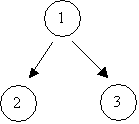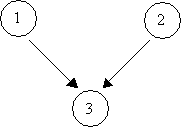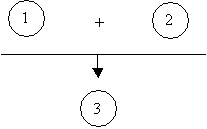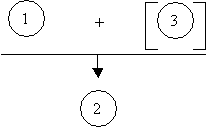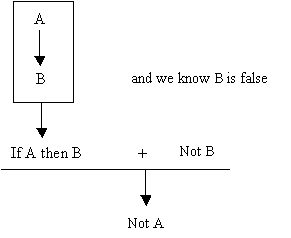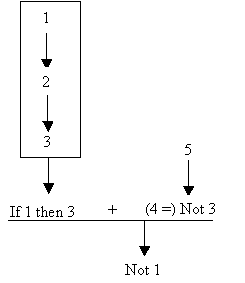| Form Analysis of Arguments | |||||||||||||||||||||||||||||||
|
|
|||||||||||||||||||||||||||||||
Reconstructing
Arguments
|
|||||||||||||||||||||||||||||||
|
Argument Completions In
the exercises for the last lecture there was an argument that seemed to
have just one premiss, so that the standard form that you were asked to
give looked like this:
United Airlines are on strike
----------------------------------
Other airlines will carry more passengers Several
of you thought that this didn’t look quite right. There didn’t seem
to be enough premisses there, or the premisses weren’t of the right
sort to support the argument’s conclusion. So when they proposed a
standard form they introduced extra statements into the argument that
they thought would justify going from the actually stated premiss to the
conclusion. Now, on the one hand, this is quite the wrong way to get a
standard form, yet, on the other hand, it does seem, in some way, to be
the right thing to do. And
of course, when we want to understand an argument it is exactly what we
need to do. Arguments just like this are what led us to propose that an
argument could not actually be defined just in terms of the standard
form. Because whereas that form – which we were then calling the
argument base – could give us some of the premisses of the argument
which we understood from the text and some of the conclusions, when we
wanted to determine whether it was a good or a bad argument we had to
define things other than the argument base. In
fact what we required was something we called an argument completion.
Let me remind you of how we thought it worked. Suppose you had an
argument that didn’t make the respondent feel
the argument intuition connecting the premisses and the conclusion, and
yet you thought it was a good argument. An argument like Arg.A.
“All men are animals and all animals are mortal and
Socrates is a man so Socrates is mortal.” which specified the argument base: F.B: < ‘All men are animals’, ‘All animals are mortal’, ‘Socrates is a man’, ‘Socrates is mortal’ > Then one way to answer the respondent’s doubts is to make the argument more explicit by breaking it up into smaller parts which are effective for the respondent. Something like this might work for example: F.1: < ‘All men are animals’, ‘All animals are mortal’, ‘All men are mortal’ > F.2: < ‘All men are mortal’ ‘Socrates is a man’, ‘Socrates is mortal’ > What
we’ve done here is to reconstruct the argument so that a sufficient
number of the intermediate steps in the intended interpretation of the
argument are made apparent to the respondent. Something
similar is done for the problematic argument with just one premiss.
It’s obvious that
< ‘United Airlines are on strike’,
‘Other
airlines will carry more passengers’ > isn’t
necessarily going to make all right thinking people immediately feel the argument intuition connecting the
premisses and the conclusion, so one good reaction to doubts about the
worth of this argument is to present more explicitly the completion of
the argument. The sort of thing that people tried was to say that the
argument was really
< ‘United Airlines are on strike’,
‘United
Airlines will not carry passengers’ >
< ‘United Airlines will not carry passengers’,
‘The
airlines as a whole have to carry so many passengers’,
‘Other
airlines will carry more passengers’ > Which
is a way of reconstructing the argument to make it more convincing. Of
course, we have a slight difficulty here in that we don’t have any
really good way of determining what’s going to count as a plausible
reconstruction, because we are just talking about this argument
intuition that is supposed to make us more disposed to accept the
conclusion to an argument if we are disposed to accept the premisses to
that argument. Now, however, we’ve got a much better idea of what can
stand in the place of this intuition, at least for a certain class of
arguments. That is the validity or invalidity of the argument. What
we’re going to do now is to see haw we can go about reconstructing
arguments using our new concept of validity as a guideline. Enthymematic Arguments The
first thing that we need to remark upon is just how essential this
ability to reconstruct arguments is. Arguments are almost never made
fully explicit outside of the artificial conversational environment of a
talk on logic or critical reasoning. In the real world, when an argument
is put forward it is common to leave some assumed premises implicit;
sometimes even the conclusion is left implicit. Considerations governing
cooperative conversational situations (e.g. politeness) often dictate
that we suppress some argumentative assumptions (i.e. premises). For
example, obvious assumptions
(e.g. that 2+2=4) are typically suppressed since to include them as
explicit assumptions conversationally implies that the audience is
unaware of them and this would be impolite. We generally explicitly
state the relevant parts of an argument that in the circumstances may be
considered to be less than completely obvious. You can see from this how
it is that the notion of conversational implicature (and of
illocutionary acts in general) that we talked about earlier can be
integrated into this business of interpreting and reconstructing
arguments.
Suppressed
Premisses Here,
for example is an argument which is an enthymeme with suppressed
premise.
'John is a native-born American so John is an American citizen' This
can plausibly be interpreted as an argument with suppressed premise 'All
native-born Americans are American citizens' — a factual premise
supplied by the American Constitution.
The
premiss in the argument discussed above might not have been explicitly
stated by a reasoner, and only after interpretation do we decide it was
implicitly assumed and was thus a suppressed premiss. Suppressed Conclusion Here
is an enthymeme with a suppressed conclusion.
'No sane person would do that but you would' This
can plausibly be interpreted, in appropriate circumstances, as an
argument with suppressed conclusion 'You're insane'
Rules of Reconstruction The
act of interpretation is guided by the Principle
of Charity. When refining an argument by means of interpretation,
always interpret it so as to make the refined argument as strong and
plausible as circumstances allow. That is, interpret the argument so
that it is as strong and plausible as possible, consistent with the
interpretation being an interpretation of the argument now before us.
The latter constraint suggests that the act of interpretation is also
guided by a Principle of Textual
Fidelity. a.
Charity Charity
is to be employed because, in this way, our inquiry as to whether or not
what is being argued for can be defended or backed up by good reasons is
sincerely and fruitfully pursued. If we reconstruct an argument in such
a way that it appears as a weak argument we do little or nothing in the
way of inquiring as to whether there are good reasons for the claim in
question. So
how do we decide that some particular premiss rather than some other
premiss is the thing to assume? What would be the strongest possible
result of a reconstruction? Obviously that would be if the argument were
valid, because then we would have no choice but to accept the conclusion
if we accepted the premisses. Therefore, what we try to do is to
reconstruct the argument in such a way that the result is an argument
that is valid. You will see that the reconstructed argument in the
example is valid, because John
is a native-born American All
native-born Americans are American Citizens ------------------------------- John
is an American citizen is
an argument in the form of S
is P All
P are Q ------------------------------- S
is Q which
is a valid form. (Just check the Venn diagrams, or consider how a
counterexample is inconceivable.) Sometimes,
however, we are not justified
in reconstructing a valid argument from the argument materials that are
provided to us explicitly – which brings us back to fidelity. b.
Fidelity Fidelity
is to be employed because we are interested whether or not the arguments
under consideration are good arguments, thus we must aim to provide an
interpretation of them (not some other, perhaps stronger, argument that
comes to mind which could in no way be attributed to the advocate of the
argument in question.) For example, suppose Bob presents the argument
John is Australian
----------------------
John is happy We
probably wouldn’t think that the appropriate reconstruction is the
valid argument
John is Australian
All Australians are happy
----------------------
John is happy because
we wouldn’t think that it’s likely that Bob actually intends us to
understand that he thinks that all Australians are happy. Nor would we
think that it should be reconstructed as
John is Australian
All Australians voted for
Howard
----------------------
John voted for Howard
John voted for Howard
Everyone who voted for Howard is happy
----------------------
John is happy for
a similar reason. And if we think through a reasonable number of such
interpretations we’ll probably conclude that the argument simply
can’t plausibly be made into a valid argument while staying faithful
to the sorts of things that we can really believe that Bob believes. In
a case like this we are prepared to be satisfied with arguments of
lesser strength. We might accept, for example, the reconstruction
John is Australian
Australians tend to be
happy-go-lucky folk
----------------------
John is happy which
is a reasonably strong argument, with a suppressed premiss that we could
reasonably believe that Bob believes.
|
|||||||||||||||||||||||||||||||
Diagramming
Arguments
|
|||||||||||||||||||||||||||||||
|
Much
of what we’ve been talking about in the preceding lectures has to do
with the forms of arguments, and an analysis of whether or not an
argument is good or bad can usefully begin with a careful study of the
form of the argument. There is a called argument diagramming which is
useful in that sort of analysis. We
use argument diagrams to represent the structure of an argument: how the
reasons are supposed to be related to the conclusion. In an argument
diagram the statements are represented by their numbers for convenience,
and the claim that the statement or the set of statements, X, supports
the statement, Y, is represented by an arrow pointing from X to Y. To
create an argument diagram begin by numbering the statements in the
argument. Then
build up a picture of the argument structure as a combination of the
four basic types of argument structure. Basic Argument Structures 1.
Serial Arguments If
we have an argument with three numbered statements, in which statement 1
is a reason that supports statement 2 (which is therefore an intermediate
conclusion), and statement 2 is itself a reason that supports
statement 3 (which is the final conclusion), the diagram looks
like:
Here’s an example. Suppose we’re given a
statement: We are under attack
from implacable enemies, so we need to protect ourselves. That’s why I
think the Patriot act is required. We can identify at least three major statements
in this argument, and so we give them numbers, like this: (1)[We are under attack from
implacable enemies], so (2)[we
need to protect ourselves.] That’s why (3)[I
think the Patriot act is required.] We can also identify a couple of argument
indicators, ‘so’, and ‘that’s why’. These are both conclusion
indicators. It’s a good idea to mark them too. So: (1)[We are under attack from
implacable enemies], so
(2)[we need to protect
ourselves.] That’s why
(3)[I think the Patriot act is required.] Given this preliminary analysis, it looks like
statement (1) is a premiss that is intended to support statement (2),
and statement (2) is therefore a conclusion. But statement (2) is also a
premiss that supports statement (3). So we think that (2) is an
intermediate conclusion and (3) is the final conclusion, and the
argument has a serial structure. 2.
Divergent Arguments If
we have an argument with three numbered statements, in which statement 1
is a reason that supports both statement 2 (which is a conclusion), and
statement 3 (which is another conclusion), then the diagram looks like:
Here’s an example. Suppose we’re given a
statement: We are under attack
from implacable enemies, so we need to protect ourselves. I also think
that we should fight back. We can again identify at least three major
statements in this argument, and so we give them numbers, like this: (1)[We are under attack from
implacable enemies], so (2)[we
need to protect ourselves.] (3)[I
also think that we should fight back.] Again we mark any argument indicators that we
find. So: (1)[We are under attack from
implacable enemies], so
(2)[we need to protect
ourselves.] (3)[I also think
that we should fight back.] Given this preliminary analysis, it looks like
statement (1) is a premiss that is intended to support statement (2),
and statement (2) is therefore a conclusion. But statement (3), which
has no markers attached, is also reasonably thought of as being a
conclusion supported by (1). If we had a statement that was just We are under attack
from implacable enemies. I also think that we should fight back. We wouldn’t doubt that this was an argument.
If that’s right, then (1) is a premiss that independently supports
both (2) and (3), and the argument has a divergent structure. 3.
Convergent Arguments If
we have an argument with three numbered statements, in which statement 1
is a reason that independently supports statement 3 (which is a
conclusion), and statement 2 is another reason that independently
supports the conclusion, then the diagram looks like:
The
important concept here is that of independent support. To say a reason
is independent is to say that if the other reasons fail, that
reason will still provide support for the conclusion. Here’s an example. Suppose we’re given a
statement: A life of crime is not
to be desired. Criminals are usually quite unhappy people, and they
often come to unpleasant ends. We can identify at least three major statements
in this argument, and so we give them numbers, like this: (1)[ A life of crime is not to
be desired.] (2)[Criminals
are usually quite unhappy people] and (3)[they
often come to unpleasant ends.] There are no indicators here, but they’re
hardly necessary. It looks like statement (1) is supposed to be the
conclusion of the argument and both statement (2) and statement (3) are
premisses that are intended to support it. Moreover, both (2) and (3)
are reasons that could support the conclusion without the help of the
other reason. So we think that the argument has a convergent structure. Convergent arguments are particularly used where
there are several reasons to believe a conclusion, but none of the
reasons is conclusive – none of them are reasonably interpreted or
reconstructed as valid arguments. 4.
Linked Arguments If
we have an argument with three numbered statements, in which statement 1
is a reason that supports statement 3 (which is a conclusion), and
statement 2 is another reason that supports the conclusion, but those
reasons are not independent, then the diagram looks like:
In
a linked argument the failure of one reason means that the argument
fails because the other reasons do not independently support the
conclusion. We’re pretty familiar with these sorts of
arguments. The Socrates argument is one, for example: Socrates is a man and
all men are mortal, so Socrates is mortal. We identify the three statements, number them;
and spot the conclusion marker, and mark it. So: (1)[Socrates is a man] and (2)[all
men are mortal,] so (3)[Socrates is mortal.] Here statement (1) is a reason for the
conclusion (3) and so is statement (2). But they only work to support
the conclusion if they are both there. If either (1) or (2) were omitted
then there would be no very great support for (3). Thus we think that
the argument has a linked structure. Arguments
that claim to provide support for a conclusion by collecting together a
large number of rather weak reasons in support of a conclusion are best
thought of as linked arguments (rather than convergent.) Hidden Elements We mark hidden premises in a diagram by enclosing the number in square brackets, e.g.
Arguments
may also have gaps that are due to some stages of the argument being
left unstated. There may be hidden intermediate conclusions that are
supported by reasons, and which also play a role as support for
((hidden) intermediate) conclusions. The interpretation of an argument
so that it relies upon hidden intermediate conclusions is again a matter
of charitable interpretation. We
mark hidden intermediate conclusions in the same way as hidden premises.
Consider
the example we used before. We’re given the statement United
Airlines are on strike, so other airlines will carry more passengers. We
do the standard analysis and we get: (1)[United Airlines are on strike], so
(2)[other airlines will carry
more passengers.] which
would be given the diagram
But
if we include the hidden intermediate conclusion that was suggested
earlier, that
(3)[The airlines as a
whole have to carry so many passengers] then
we can see the argument as having the following form.
The
possibility of hidden premises and intermediate conclusions means that
the charitable interpretation of an argument may be very much more
complex than the expressed argument. Conditionalisation I’ll
take the opportunity now of introducing the notion of conditionalisation. If we
have an argument of the form:
(where
the inference (a) may abbreviate a very long and complex argument) and
every inference in that argument is deductively valid, then we can
deduce the conditional statement ‘If A then B’. This is the conditionalisation
of the argument from A to B. We could diagram it as:
We
can use conditionalisation and modus tollens to create a form of
argument that refutes a statement by showing that it contradicts another
statement that we know to be true.
Reductio ad absurdum (RAA):
Here’s an example. Suppose we’re given a
statement: I know that I do not
know anything. There’s an argument against this that goes: Suppose it’s true
that I know that I don’t know anything. If that’s the case then
it’s also true that I don’t know that I don’t know anything. So I
both know and don’t know that I don’t know anything. But that’s
absurd because I can’t both know and not know the very same thing.
Thus it can’t be true that I know that I don’t know anything. We can identify the major statements and
indicators in this argument like this: Suppose it’s true that 1(I know that I don’t know anything.) If 1(that’s the case) then it’s also true that 2(I don’t know that I don’t know anything.) So 3(I both know and don’t know that I don’t know anything.) But 4(that’s absurd) because 5(I can’t both know and not know the very same thing.) Thus 5(it can’t be true that I know that I don’t know anything.) This argument structure looks like this:
which is the structure we assigned to a RAA
argument. Complex Arguments Complexity
in arguments can also be the result of the argument being a combination
of the basic forms. This is best seen in some examples. 1.
1(In
rape cases, sentences should be lighter for those who plead guilty than
for those who plead not guilty.) 2(Appearing
in court is a very distressing experience for a victim of rape.) 3(If
the defendant pleads guilty, the victim does not have to appear in
court.) 4(If sentences are as heavy for those who plead guilty as
for those who plead not guilty, all defendants will plead not guilty), because
5(there is nothing to lose.) 5 a ¯ 2 +
3
+
4 b¯ 1 There is one inference indicator here, but it points toward the conclusion of a subargument. The main conclusion is stated in the first sentence and the argument in support of it then follows. The structure is rather similar to that of the previous argument, but with more reasons linked. 2.
1(Our
souls are immortal.) We know
this from 2(revelation),
but we also know it by
3(philosophical
argument.) 4(For
example, we can prove the immortality of the soul by simply attending to
its indivisibility), for
5(only composite things can be destroyed) and because
6(it is pure substance) 7(the soul is incomposite.) 6 a¯ 5
+
7 b¯ 4 c¯ 2 3 d¯ e¯ 1 We now begin to see how arguments can be of almost arbitrary complexity. In this case we have several subarguments that form subordinate parts of an argument whose overall form is convergent. The argument says that we know the truth of the conclusion by revelation (2) and also by philosophical argument (3). If the philosophical argument failed the revelation would still remain, and vice versa. The argument then sets aside revelation to concentrate upon the philosophical argument. It states in (4) what sort of philosophical argument will prove the conclusion. (4) thus supports the claim in (3), which is thus an intermediate conclusion as well as being a reason supporting (1). The claim in (4) is then made an intermediate conclusion itself, being supported by a linked argument from (5) and (7). Finally, (7) is supported by (6), making (7) too an intermediate conclusion.
|
|||||||||||||||||||||||||||||||
Examples
of Dialectic Analysis
|
|||||||||||||||||||||||||||||||
Reasons against a conclusion
1(We need to generate
2(Nuclear power plants more electric power) are very controversial)
¯
~¯
3(We should build more
nuclear power plants) 2
2 ~¯
=
¯ 3
not 3 Reasons against a reason
4(If we were more careful users,
we wouldn’t
need more power)
~¯
3(We
need to generate
more electric power) Reasons against an inference
1(We need to generate
more electric
power)
5(Coal-fired power
stations are much ~®¯
easier to build)
3(We should build more
nuclear
power plants) A
Debate Alice:
1(A good
God would not allow her creatures to suffer pointlessly) and 2(an
all-powerful God would be able to prevent this happening.) But 3(there
is a great deal of pointless suffering in the world.) Therefore 4(the
world could not have been created by an all-good and all-powerful God.) Bob: I disagree. 5(Suffering
is a vital part of a person’s spiritual and personal development), and
6(something that
is vital in that way can’t be described as pointless.) Alice:
I’ve heard that argument before, but 7(some
suffering is actually destructive of people’s spiritual and personal
development.) For example, 8(a
child that is tortured and murdered would have suffered terribly without
that suffering contributing to their personal or spiritual growth.) Bob: Well maybe, but consider
this: 9(pointless suffering (for example, the suffering of a
murdered child) is brought about by God’s creatures, not God herself.)
10(These creatures
(both human and non-human) create suffering through their wilful
actions.) 11(Wilful
actions come about through the exercise of free-will) and 12(it
is better for God to have created a world in which her creatures have
free will than a world in which they must automatically follow a
pre-determined path.) Thus 13(a
good God, should, after all, create a world in which her creatures
experience pointless suffering.)
Para.
1:
1
+
2
+
3
¯
4 Para.
2:
5 &nbÿÿ;&ÿÿsp;
ÿÿ/span>+
6
~¯
1
+
2
+
3 ¯
4 Para.
3:
8
¯
7
~¯
5
+
6
~¯
1
+
2
+
3
¯
4 Para.
4:
8
¯
9 +
10 + 11 +
12
7
¯
~ ¯
13
5
+
6
~¯
¯~
1
+
2
+
3
¯
4 |
|||||||||||||||||||||||||||||||
